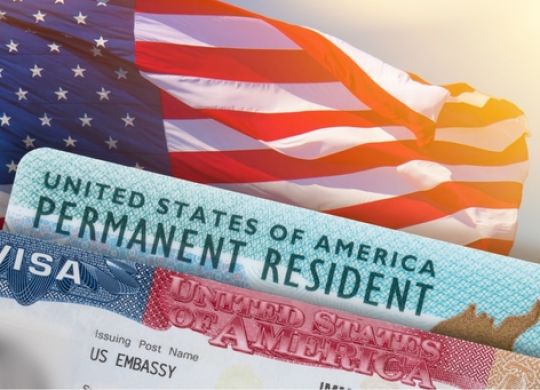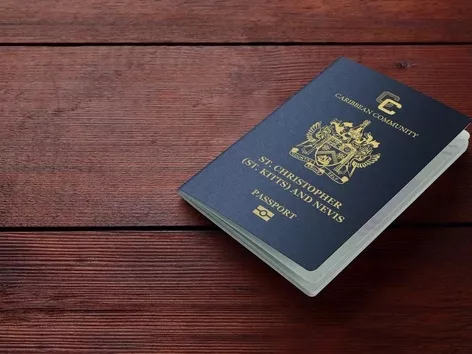EB5 visa program in the USA: a detailed guide
Table of contents
- What is an EB-5 visa?
- The main advantages of the EB-5 visa
- Requirements for applicants for the US EB-5 visa program
- What can I invest in under the EB-5 visa program?
- Regional Centers
- EB-5 immigrant program application process
- US citizenship by investment
- Immigration to the United States for family members

With the EB-5 immigrant visa program, wealthy foreigners can obtain permanent residency in the United States through an investment of $800,000 or more. Learn more about the conditions and basic requirements of the EB-5 investment visa program in the United States
Established in 1990, the EB-5 visa program creates opportunities for foreign investors by contributing to the economic development of American communities. This program allows investors to obtain a Green Card by investing in projects that stimulate economic growth and create or retain jobs in the United States. In order to obtain permanent residence, investors must invest a certain amount of money in a new commercial enterprise or in regional centers engaged in various economic projects.
The EB-5 program is an important component of the US immigration policy, as it not only helps to attract foreign investment, but also provides investors and their families with a legal path to permanent residence in the country. This program is popular among investors seeking to relocate to the United States and contribute to economic growth by creating new jobs. According to statistics, the most frequent participants in the EB-5 visa program are citizens of China, Vietnam, India, and Mexico.
You can learn more about the August US visa bulletin here.
What is an EB-5 visa?
An EB-5 visa is an immigrant visa designed for investors, entrepreneurs, and anyone else who wishes to start a business in the United States. To be eligible for an EB-5 visa, you need to invest at least $1,050,000 in a US business. If the investment is located in an economically depressed region, known as a “targeted employment area,” the minimum amount may be reduced to USD 800,000.
In addition to the investment amount, the business must create at least 10 full-time jobs for U.S. workers and be commercial and profitable. Investments in real estate or non-profit businesses are not eligible for the EB-5 program.
An investor can obtain an EB-5 visa through a direct investment or through a regional center. Regional centers collect investments from several EB-5 investors to finance large-scale projects, such as resorts or residential complexes. A direct investment involves starting your own business or buying an existing business, without the involvement of a regional center.
The EB-5 visa is an immigrant visa, so successful applicants receive a green card. This also allows the investor's spouse and children to obtain green cards. The process of obtaining a green card under this visa consists of two stages. First, the investor becomes a conditional permanent resident for 2 years. After this period, the investor can remove the conditions from the green card by proving that 10 jobs have been created and the invested capital has been maintained throughout the entire period.
The main advantages of the EB-5 visa
The EB-5 visa offers numerous benefits for successful applicants. One of the main advantages is that it belongs to the category of immigrant visas, allowing to obtain a green card and paving the way for US citizenship. In addition, the investor can include his/her spouse and unmarried children under the age of 21 in the application, who can also apply for a green card.
The investor's children get access to American education, which is an important aspect for many families. EB-5 visa holders are not required to work for the sponsoring company, which gives them the freedom to work in any legal field. This means that they can choose to work and live anywhere in the United States without restrictions.
In addition, EB-5 visa holders are eligible to work in the United States without having to apply for a special work permit. This provides additional flexibility and freedom for investors and their families, helping them to integrate more easily into American society and economy.
Requirements for applicants for the US EB-5 visa program
To participate in the EB-5 immigrant investor program, foreign investors must meet certain investment and job creation requirements. These requirements are set by the U.S. Citizenship and Immigration Services (USCIS) to ensure that the program stimulates the U.S. economy by attracting foreign capital and creating jobs.
Investment thresholds
The EB-5 program requires a minimum investment of USD 1,050,000. However, if the investment is made in a Targeted Employment Area (TEA), which includes rural areas or areas with high unemployment, the minimum amount is reduced to USD 800,000.
So, the main requirements of the EB-5 program are:
1. Total minimum investment: 1,050,000 USD
2. Investment in TEA: USD 800,000
TEAs are designated by the U.S. Citizenship and Immigration Services (USCIS) based on various economic factors. Investments in these areas are encouraged as they aim to support economic development in the most needy parts of the country. This ensures that the EB-5 program not only benefits investors, but also helps to create jobs and stimulate economic development in regions with a high need for investment.
Job creation criteria
In order to obtain an EB-5 visa, at least ten full-time jobs must be created or retained for qualified American workers. These jobs must be created within two years from the date when the immigrant investor receives conditional permanent resident status in the United States. In some cases, the US Citizenship and Immigration Services (USCIS) may grant a one-year extension to meet this requirement.
Investors must demonstrate that their investment directly or indirectly contributes to the creation of these jobs in accordance with USCIS standards. This can be accomplished through direct investment in a new commercial enterprise or through investment in regional centers that pool funds for larger projects.
Compliance with legal and regulatory requirements
Foreign investors participating in the EB-5 program must prove that they are investing in a legitimate enterprise and that their funds were obtained legally. This includes compliance with the investor's legal obligations in accordance with all aspects of the program and the US Citizenship and Immigration Services (USCIS) guidelines.
In addition, the program provides for various regulatory measures to minimize risks for both the project and the investor. For example, the EB-5 Integrity Fund has been established to ensure ongoing compliance with the program's rules. This fund helps protect investors by reducing the risks associated with unfair projects or fraudulent schemes.
What can I invest in under the EB-5 visa program?
The EB-5 program in the United States provides foreign investors with a variety of entrepreneurial opportunities. The main focus is on investments in development projects, especially real estate, as the construction industry makes it easy to control the creation of new jobs.
Investors can finance the following types of facilities:
1. Agricultural projects, farms, and wineries;
2. Hotels and restaurants;
3. Stadiums and gyms;
4. Entertainment centers and casinos;
5. Medical technologies;
6. Office buildings;
7. Shopping centers and shops;
8. Production of electric vehicles.
These investment options contribute to economic development and job creation in the United States, which is the main goal of the EB-5 program.
Regional Centers
In 1993, the US government launched the EB-5 Regional Centers program to effectively attract foreign investment into the US economy. It created a network of accredited institutions and corporations that attract, pool and distribute investment funds. Investors wishing to obtain a Green Card can invest through these regional centers.
Using state-approved intermediaries has two key advantages:
1. The ability to invest funds together with other investors on the basis of a limited liability partnership;
2. Accounting for both direct and indirect jobs created by the investment.
The choice of a regional center is an important decision, as not all centers operate equally well. Investors should make sure that the selected company can help fulfill the requirements of the immigration program and ensure a return on investment at the end of the investment period.
When choosing a regional center, investors are advised to consider the following factors:
1. The duration of the company's operation;
2. Number of successful projects implemented;
3. Reasons for possible failures;
4. Terms of return on investment funds;
5. Cooperation with builders and developers;
6. Existence of lawsuits against the company.
Investments through regional centers are passive, which means that after transferring funds, the investor is not required to actively participate in the development of the project. The company is responsible for its implementation. To ensure compliance with all immigration requirements and a high probability of return on investment, it is recommended to entrust the selection of a regional center to a qualified immigration lawyer.
For safe relocation to any country in the world, obtaining citizenship and employment, use the advice of an international lawyer. We help to solve complex and simple issues for your comfort and safety in any part of the world.
EB-5 immigrant program application process
The EB-5 application process is a structured path that requires careful documentation and adherence to U.S. Citizenship and Immigration Services (USCIS) protocols.
1. Form I-526: Immigrant Petition of a Foreign Investor
The first step to participate in the EB-5 program is to file Form I-526, which is called the “Immigrant Petition for a Foreign Investor”. This form confirms that the applicant has invested or plans to invest the required amount in a qualified business in the United States.
In addition, the applicant must demonstrate that his or her investment will create at least 10 full-time jobs for American workers. This is an important criterion for the approval of the petition and subsequent receipt of an EB-5 immigrant visa.
2. Change of status compared to the consular procedure
After the approval of the I-526 form, candidates residing in the United States may file an I-485 form with the USCIS to change their status to conditional permanent resident.
For those residing outside the United States, it is necessary to go through the consular procedure. This involves applying for an immigrant visa at a US consulate abroad. After receiving a visa, they can enter the United States as conditional permanent residents. Both options are part of the process of obtaining permanent residence under the EB-5 program.
3. Form I-829: petition of the entrepreneur for the cancellation of conditions
After two years of conditional permanent resident status, EB-5 applicants must file Form I-829, “Petition of the Entrepreneur for Waiver of Conditions” with the US Citizenship and Immigration Services (USCIS). This form confirms that all program requirements have been met and requests the cancellation of conditional status for lawful permanent residence.
Approval of Form I-829 grants the investor, his or her spouse and unmarried children under the age of 21 permanent resident status. This is the final step in the process of obtaining a permanent green card under the EB-5 program.
Permanent residence and citizenship
The EB-5 visa serves as a bridge for investors and their immediate family members to move from conditional permanent residence to full permanent residence and, ultimately, to U.S. citizenship.
Once an investor has met the investment requirements of the EB-5 program, he or she and his or her immediate family are eligible for U.S. permanent residence. This status is initially granted for a two-year period.
Transition to permanent resident status
Transition to permanent resident status requires filing a petition with the Department of Homeland Security to remove the conditions. Investors must complete this procedure before the end of the two-year conditional period. To obtain a green card, proof must be provided that the investment has been made and the job creation requirement has been met.
The green card allows its holder to live and work in the United States indefinitely. This document grants permanent residency, providing stability and legal status for investors and their families.
The naturalization process
To obtain citizenship through naturalization, a permanent resident must reside in the United States continuously for at least five years after receiving a green card. They must also meet all other requirements set by the US Citizenship and Immigration Services (USCIS).
After fulfilling these requirements, the investor, his/her spouse and children under the age of 18 can apply for naturalization and become US citizens. The naturalization process involves submitting an application, passing an interview, and passing an exam on English language skills and basic knowledge of U.S. history and government.
US citizenship by investment
An alien who has participated in the EB-5 immigration program and obtained permanent resident status is eligible to apply for US citizenship. The investor and his/her family members can start the process 90 days before the end of the five-year period from the date of receipt of the initial green card.
To apply for citizenship, an applicant must meet the following requirements:
1. Age of 18 years or older;
2. Reside legally in the United States for the last 5 years;
3. Be physically present in the country for at least 30 months of those 5 years;
4. Have an impeccable reputation and no problems with the law;
5. Adhere to the principles and ideals of the U.S. Constitution;
6. Be proficient in English (reading, writing, speaking);
7. Have knowledge of the history, principles and forms of government of the United States;
8. Be willing to take an oath of allegiance to the country.
The application is submitted to the U.S. Citizenship and Immigration Services (USCIS) office located in the jurisdiction where the applicant has resided for the last three months.
Immigration to the United States for family members
The EB-5 program provides an opportunity to immigrate to the United States with close relatives. The spouse and unmarried children under the age of 21 go through all stages of the procedure together with the main applicant. The participation of relatives does not affect the amount of investment, but they are subject to registration fees for the review of documents.
Family members receive a primary residence permit, which can be changed to a permanent residence permit without conditions after two years. After that, they are eligible to work and study in the United States.
The EB-5 program is an effective way to become a permanent resident of the United States. It has a number of advantages: high chances of a successful outcome, no language skills or entrepreneurial experience requirements, the ability to not be involved in project implementation, and a return on investment.
Engaging a qualified immigration lawyer increases the likelihood of success by helping to reduce investment risks and ensure compliance with all legal requirements.
We remind you! Residing and legalizing in the United States provides an opportunity to get a good job and a decent salary. To move to the United States, a foreigner must obtain an immigrant visa and then a Green Card. Read more about the proven ways to legally migrate to the United States and other important details for expats.
Igor Usyk - Head of Migration department at VisitWorld
To ensure a safe trip abroad, I advise you to contact a specialist. My colleagues, qualified specialists with legal education, will help you avoid unpleasant situations while traveling around the world.
Products from Visit World for a comfortable trip:
Checklist for obtaining a visa and necessary documents in the USA;
Legal advice on immigration to the USA;
Travel insurance for foreigners in the USA;
Medical insurance all over the world.
Recommended articles
2 min
Popular
Move to Tuscany: Italy will pay from 10,000 euros to foreigners who settled in mountain towns
Tuscany is one of the most famous regions of Italy, which attracts many tourists with fantastic landscapes, perfect villages and the most delicious dishes. However, the economic crisis contributes to the reduction of the local population. To attract new residents, the regional government launched the "Residence in the Mountains 2024" program. Find out how a foreigner can get from €10,000 to move to Tuscany and how attractive the prospect of living here is
31 Jul. 2024
More details1 min
Residence permit
Hong Kong has resumed its investment residence permit program. From now on, you can move to the state if you make an investment of 30,000,000 Hong Kong dollars. Find out who can apply, what criteria and features
16 Dec. 2024
More details1 min
Investment
Citizenship by Investment: The Federation of St. Kitts and Nevis has reduced the cost of its program
St. Kitts and Nevis is a Caribbean island nation that offers a passport for investment. Citizenship of the state allows you to enjoy comfortable trips to Europe and North America. In 2024, the country reduced the cost of its program. Find out how much money a foreigner needs to invest in 2024 to get a second passport here
28 Jul. 2024
More details3 min
Investment
TOP-10 countries with the best programs for immigrant investors in 2024
Investing in another country's economy is one of the easiest ways to become a citizen. Learn more about the best programs for immigrant investors in 2024
31 Jul. 2024
More detailsAll materials and articles are owned by VisitWorld.Today and are protected by international intellectual property regulations. When using materials, approval from VisitWorld.Today is required.
